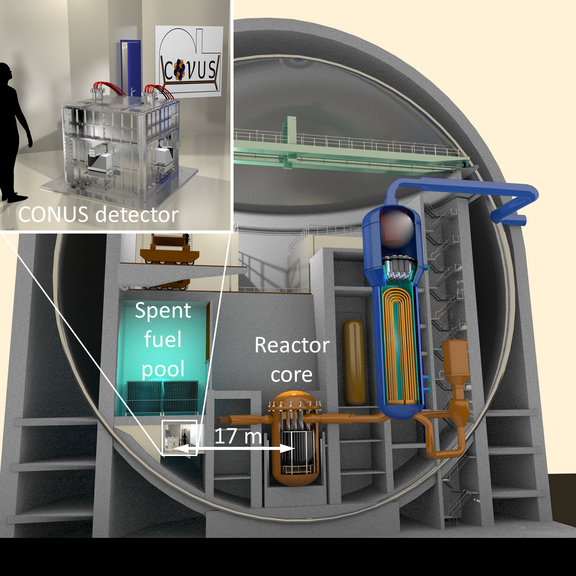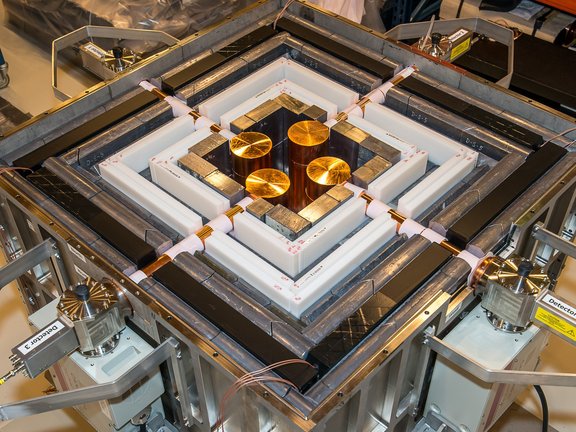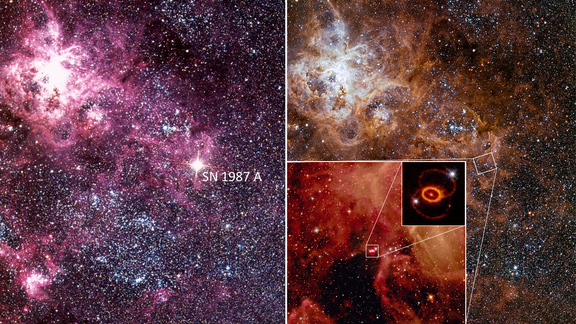The keyword “neutrino experiment” makes experts inevitably think of gigantic detector systems with many tons of material that are necessary to detect these extremely weakly interacting and therefore extremely penetrating elementary particles. A cubic kilometer of the Arctic inland ice (IceCube) or the water of the deep sea (ANTARES) are, for example, used to investigate cosmic neutrinos, which corresponds to 1 billion tons.
Neutrinos interact in principle with matter in two ways: either with electrons in the atomic shell or with single neutrons or protons in the atomic nucleus. The latter offers also the possibility that a neutrino interacts “coherently” with the nucleus as a whole, which increases the probability of such a scattering process significantly. This can be compared to a game of skittles: a single hit knocks down all nine! In the case of coherent scattering, the probability of a hit increases with the square of the number of neutrons in the atomic nucleus. For the element germanium, for example, the high number of neutrons results in an enhancement factor of around 1600! In principle, an increase in the coherent interaction of up to three orders of magnitude can thereby be expected in comparison to other neutrino interactions. However, this mechanism also has a disadvantage: For coherent scattering, the energy of the neutrino has to be low enough to ensure that the wavelength of the neutrino has at least the same magnitude as the atomic nucleus (10–15 m). Neutrino scattering transfers then very little recoil energy to the comparatively heavy atomic nucleus – just like shooting at a truck with grains of sand. The detection system must therefore have a very low detection threshold. Altogether there is nevertheless a big advantage: Neutrino detectors on a kilogram instead of a ton scale are feasible!
The enormous requirements of such experiments hindered an experimental proof of the theoretical predictions from the 1970s for more than 40 years. In 2017, coherent scattering of neutrinos off nuclei was first observed in the COHERENT experiment at higher energies. More precise measurements in the fully coherent regime with low-energy reactor neutrinos, are still pending. Scientists from the Max Planck Institute for Nuclear Physics (MPIK) in Heidelberg have met this challenge with the CONUS (COherent Neutrino nUcleus Scattering) project in collaboration with the Brokdorf nuclear power plant. A nuclear power plant provides ideal conditions to demonstrate and characterize coherent scattering of neutrinos off nuclei. The reactor is a very powerful, controlled source of neutrinos, and the closer the detector set-up is to the source, the more intense the flux.
In the Brokdorf nuclear power plant operated by PreussenElektra GmbH, MPIK has found a partner who actively supports the institute's research work and has made it possible to set up the detector only 17 meters away from the reactor core (see Fig. 1). An extremely intense flux of 23 trillion antineutrinos per second and square centimeter from one of the world's most powerful reactors is available for measurements without affecting the reactor in any way. The combination with the very special shielding and with optimized detectors makes the experiment the leading project in this field.
In order to minimize background events which may disturb a signal and which originate from cosmic radiation or natural radioactivity, CONUS contains high-purity semiconductor detectors made of germanium, which are surrounded by a shield made of several layers of high-purity lead and borated polyethylene (see Fig. 2). The installation is furthermore shielded from cosmic radiation by concrete and water of the reactor building (see Fig. 1). Rmaining backgrounds are detected and discarded in real time with a veto system. A coherently scattering neutrino generates a small ionization inside the germanium detector which is extracted by an applied electric field, then amplified and recorded by the detector electronics. Due to the very low recoil energies, the detection threshold of the germanium detectors was lowered to record values. The design of the shielding and the entire detector system is based on many years of experience at MPIK which holds a world-leading position in this field.
After a total of almost 70 days of effective measurement time with 3.73 kg of active detector material led to the first results which have now been made public. 16 days without reactor operation were used to determine and analyze the background precisely. Although no signal of the sought-after coherent neutrino scattering has yet shown up, the most precise upper limit for the probability of this scattering process could be determined, in which neutrinos with a kinetic energy of 10 million electron volts generate recoils of up to a few 1000 electron volts (eV). 1 eV corresponds to the typical energy of a single photon of visible light. With an extremely low detection threshold of approximately 300 eV, the CONUS detectors are ideally suited for this.
This upper limit constitutes already very valuable information for basic neutrino research. It tests predictions for the strength of the coherent neutrino scattering in the standard theory or in variations. It is also of great importance for astrophysics and cosmology. It also a test ground for experiments searching for dark matter: With increasing sensitivity, detector systems for dark matter will also detect coherent scattering of neutrinos from natural sources (e.g. the Sun), which then represents a disturbing background that cannot be turned off. The new upper limit allows better predictions when this “neutrino floor” will be reached, for which only calculations are currently available.
Small neutrino detectors based on coherent scattering would also open a new era in neutrino astronomy. A very interesting source of neutrinos are supernovae, those gigantic explosions at the end of the development of very massive stars. Core collapse supernovae happen when fusion processes stop to produce energy in the center of the star. The core collapses then under its own gravitational pressure and transforms into a neutron star or a black hole. 99% of the total energy released is emitted in the form of neutrinos! This happens a few hours before the supernova becomes optically visible. In 1987, a supernova lit up in the Large Magellanic Cloud neighbouring our galaxy – the most recent event so far in our closer cosmic environment (see Fig. 3). Neutrino experiments carried out at that time were able to detect neutrinos from this supernova. This was one of the main results for which Masatoshi Koshiba received the Nobel Prize in Physics in 2002.
The collapse generates such an enormous density in the centre of a supernova that even neutrinos can no longer escape unhindered. Coherent neutrino scattering plays a central role in modelling and understanding these processes. To observe a supernova like 1987A, a detector of the 100 kg class would be sufficient; the coherent scattering would have a twofold effect: in the creation as well as in the detection. Such neutrino detectors are therefore a potential “early-warning system” for the observation of supernovae with optical telescopes.
Another property of coherent neutrino scattering at atomic nuclei is its "flavour independence". There are three types (“flavour”) of neutrinos: electronic, muonic and tauonic, which can transform into one another by so-called neutrino oscillations (Nobel Prize in 2002). In experiments, e. g. that only see electronic neutrinos, only about 30% of solar neutrinos are detected. In the case of detection by coherent scattering, this would not play a role and the yield would accordingly be 3 times higher, which can be very beneficial in combination with oscillation measurements.
Coherent neutrino detectors are also of interest for non-proliferation applications: They are small and mobile and can be used for monitoring: In a running reactor, they provide real-time information about the reactor state without any thermal delays. Another possible application would be to control the plutonium inventory.
With additional data and an optimized suppression of background events, the sensitivity of the CONUS detector will be further increased. Since the expected signal is not far from the current limit, there is a realistic chance that within the next two years CONUS will see reactor neutrinos for the first time worldwide via the new channel of coherent scattering on atomic nuclei. Furthermore, CONUS has a modular structure and can therefore be expanded without major changes to the design.
Original publication:
First constraints on elastic neutrino nucleus scattering in the fully coherent regime from the CONUS experiment
H. Bonet, A. Bonhomme, C. Buck, K. Fülber, J. Hakenmüller, G. Heusser, T. Hugle, M. Lindner, W. Maneschg, T. Rink, H. Strecker, R. Wink (CONUS Collaboration)
arXiv:2011.00210 (hep-ex)
Further Information:
CONUS Experiment (Division „Particle and Astroparticle Physics“ at MPIK)


